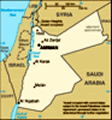Advertisement
Published: March 11th 2020
We were all exhausted from walking around Petra yesterday, so luckily we had a leisurely start. We left the town of Petra at 10 a.m. and drove through a really rugged part of Jordan. We just kept climbing past this rocky terrain until we topped out at about 5000 feet. Then we descended down to Wadi Rum, the next stop in our itinerary.

We started in Amman in the north and went further north to Jerash, then to the Dead Sea. From there we continued south to Mt. Nebo, Madaba, and Petra. Now we are going to Wadi Rum and will continue to Aquaba tomorrow.
Wadi Rum (
Arabic: وادي رم
Wādī Ramm), known also as the
Valley of the Moon (
Arabic: وادي القمر
Wādī al-Qamar), is a valley cut into the sandstone and granite rock in southern
Jordan 60 km (37 mi) to the east of
Aqaba; it is the largest
wadi in Jordan.

Petroglyphs at Wadi Rum
Wadi Rum has been inhabited by many human cultures since prehistoric times, with many cultures–including the
Nabataeans–leaving their mark in the form of rock paintings,
graffiti, and temples. In the West, Wadi Rum may be best known
for its connection with British officer
T. E. Lawrence, who passed through several times during the
Arab Revolt of 1917–18.
Khaz'ali Canyon in Wadi Rum is the site of
petroglyphs etched into the cave walls depicting humans and antelopes dating back to the
Thamudic times. The village of Wadi Rum itself consists of several hundred
Bedouin inhabitants with their goat-hair tents and concrete houses and also their four-wheel vehicles, one school for boys and one for girls, a few shops, and the headquarters of the
Desert Patrol.
Wadi Rum is home to the Zalabia Bedouin who, working with climbers and trekkers, have made a success of developing eco-adventure tourism as their main source of income. The area is one of Jordan's important tourist destinations, and attracts an increasing number of foreign tourists, particularly trekkers and climbers, but also for camel and horse safari or simply day-trippers from Aqaba or
Petra. Its luxury camping retreats have also spurred more tourism to the area.
Popular activities in the desert environment include camping under the stars, riding Arabian horses, hiking and
rock-climbing among the massive rock formations. All Terrain Vehicles (ATVs) and Jeeps are also available and new camps have opened that offer
accommodation for tourists.
Many movies have been filmed here:
•
The Martian – filming for the
Ridley Scott film began in March 2015, for shots that stood in for the surface of Mars.
•
Rogue One: A Star Wars Story, used for scenes set on
Jedha.
• The 2019 live-action adaptation of
Aladdin.
•
Star Wars: The Rise of Skywalker, used for the desert planet Pasaana.
•
Dune (2020), used as a location for the
desert planet Arrakis.
We drove to Sammy's camp and had lunch. Then we all piled into the back of pickups and they drove us all over the place, showing us arch formations, bedouin lifestyle, places for camel rides, film locations, and watching the sunset. We got to our camp about 6 p.m., and dinner was ready by 6:30 p.m. The meat was cooked in a pot underground (called zarb). It takes about 3 hours to do it this way. Then we had a surprise birthday cake for Wendy (this is my 2nd surprise birthday cake on this trip - first one on the felucca, now one in Bedouin camp). Zarb is one of the beautiful and delicious treasures of Bedouin culture. For centuries Bedouins in the whole
Arabian Peninsula cooked their food underground in earth ovens. This way of cooking does not require much equipment. Which was important as Bedouin traveled a lot as they roamed the desert in search of water and pastures. Over time a few things changed. For example, nowadays we use metal ovens. And if we wrap the meat we use foil instead of palm leaves.
We walked up the hill and did some stargazing, then the moon came up, then we sat around the campfire and cooked marshmallows. The Bedouin camp is one of the highlights of this trip for me. It's very peaceful here, out in the desert, with no city lights or noise. We each had rooms too. I opted to skip the camel ride because I had done it in Morocco.We have heard that Israel is requiring anyone who enters to have a 14 day quarantine period. Talal, our leader said GAdventures was trying to work things out, but it doesn't look good. We don't have wifi at the Bedouin camp so we have to wait to see what will happen.
Advertisement
Tot: 0.186s; Tpl: 0.019s; cc: 8; qc: 41; dbt: 0.0792s; 1; m:domysql w:travelblog (10.17.0.13); sld: 1;
; mem: 1.1mb


























